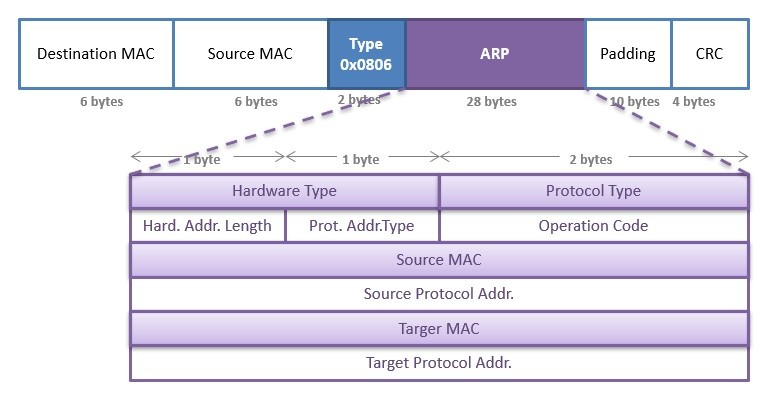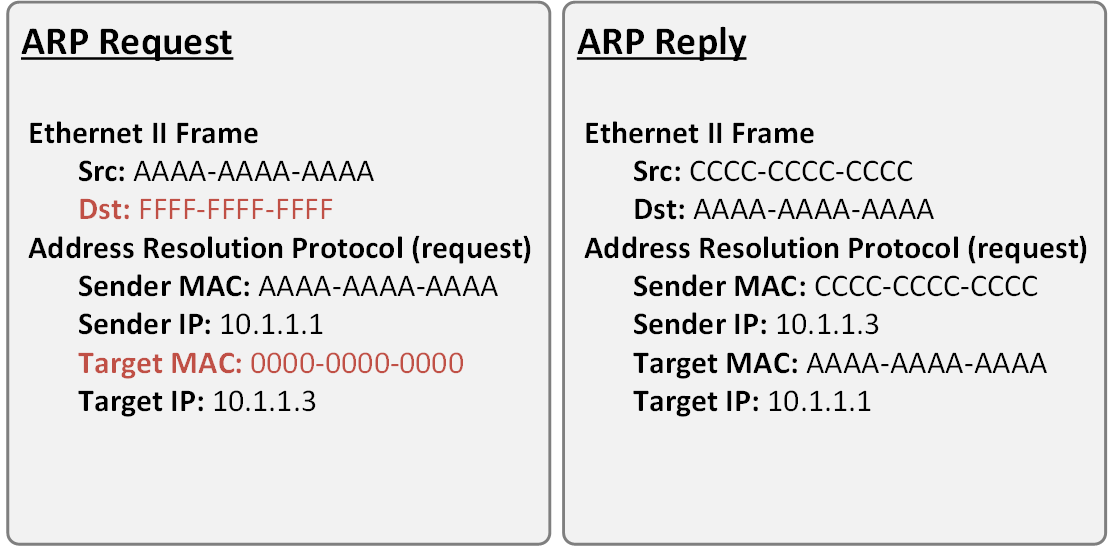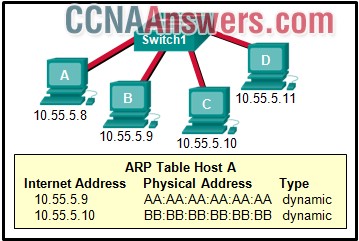Which Destination Address is Used in an Arp Request Frame
The size of the ARP message depends on the upper layer and lower layer address sizes which are given by the type of networking protocol usually IPv4 in use and the type of hardware or virtual link layer that the upper layer protocol is running on. If this target sees an ARP request it will automatically reply with an ARP reply.

Arp Address Resolution Protocol Explained
Note that the ARP Reply has the Opcodef filled as 2 which is used to identify it as a ARP Reply.

. Since the ARP request is a broadcast it reaches all the nodes in the Subnet A which includes the e0 interface of the router but does not reach Host D. When the ARP message is not an ARP request or when the ARP request isnt for an IP address on an Ethernet network it is ignored by this target CONTINUE. Encapsulation of IP datagrams and ARP requests and replies on IEEE 802 networks other than Ethernet use Subnetwork Access Protocol SNAP.
Which destination address is used in an ARP request frame. When sending a packet to a remote destination a host will need to send the packet to a gateway on the local subnet. The description is preceded by a time stamp printed by default as hours minutes seconds and fractions of a second since midnight.
The ping utility was written by Mike Muuss in December 1983 during his employment at the Ballistic Research Laboratory now the US Army Research LaboratoryA remark by David Mills on using ICMP echo packets for IP network diagnosis and measurements prompted Muuss to create the utility to troubleshoot network problems. The ARP request packet is then encapsulated in an Ethernet frame with the MAC address of Host A as the source address and a broadcast FFFFFFFFFFFF as the destination address. Host A now has enough information to send the traffic to host B.
The source device will not know the MAC address of the remote host. A MAC address table sometimes called a Content Addressable Memory CAM table is used on Ethernet switches to determine where to forward traffic on a LAN. The default is the broadcast address ffffffffffff.
The protocol must be specified as ARP. The Address Resolution Protocol uses a simple message format containing one address resolution request or response. First you can leverage the ping command to send out a ping request to a broadcast address.
0000 255255255255 FFFFFFFFFFFF AAAAAAAAAAAA the physical address of the destination host Answers Explanation Hints. The ARP request message has the following fields. The ARP request packet is then encapsulated in an Ethernet frame with the MAC address of Host A as the source address and a broadcast FFFFFFFFFFFF as the destination address.
The ARP Request is an ARP payload carried within the appropriate L2 frame for the medium in use. It dynamically maps local DHCP or remote IP addresses when you configure frame relay. ARP Address Resolution Protocol is a low level protocol working at Link layer level of the Internet Model or Internet protocol suite.
A Destination MAC address a Source MAC address and an EtherType. The Layer 3 device on the destination device network uses ARP to obtain the MAC address of the destination device and delivers the packet. The majority of the time this will be Ethernet which will also be the L2 medium we will be looking at in our examples.
Nping allows to generate packet under many protocols as it official website describes it can also be used for ARP poisoning Denial of. Each device on the segment will receive the packet but because the destination IP address is host Bs IP address only host B will reply with the ARP reply packet listing its MAC address. If a person at a computer wants to test the Layer 3 network connectivity to another computer located locally or remotely he can use network troubleshooting tools like Ping TracerouteTracert Pathping etc to generate and send ICMP.
When the computer with the IP Address 1921680122 receives the ARP Request it must prepare an ARP Reply and send back to the computer who sent the ARP Request. When a frame is sent to a device not on the local network the gateways MAC address is used in the frame header. The author named it after the sound that sonar.
The used MAC address for the reply can be specified. ICMP Echo Request and ICMP Echo Reply messages are used for network connectivity testing and troubleshooting purposes. An ARP request will be sent by the source and will be responded to by the router.
The purpose of an ARP request is to find the MAC address of the destination host on an Ethernet LAN. The gateway address must be configured on each host. It is used to find layer 3 address from layer 2 address like DLCI in frame relay.
The network host IP interface binds the gateway address to the MAC address of the physical gateway by broadcasting IP datagrams and caching the MAC address of the reply from the gateway in an ARP table. Most operating systems will also respond if the ARP request is sent to their MAC address or to a multicast address that they are listening on. In some circumstances we want to route packets differently depending not only on the destination addresses but also on other packet fields such as source address IP protocol transport.
For example if you wanted to discover all the IPs connected to the 1921681024 network you can type. A table is created by the network administrator in the gateway-router that is used to find out the MAC address to the corresponding IP address. When using inverse ARP we know the DLCI or remote router but dont know its IP address.
A frame is encapsulated with source and destination MAC addresses. Classic routing algorithms used in the Internet make routing decisions based only on the destination address of packets and in theory but not in practice on the TOS field. Because the gateway will be the Layer 2 destination for the frame on this LAN segment the destination MAC address must be the address of.
Tcpdump prints out a description of the contents of packets on a network interface that match the Boolean expression see pcap-filter7 for the expression syntax. When using Nmap on a local network ARP protocol is applied by default for being faster and more reliable. ARP Reply will be a unicast to save Network Resources.
--destaddr or -T Send the packets to Ethernet MAC address This sets the 48-bit destination address in the Ethernet frame header. MAC Address Tables. The ARP process sends a Layer 2 broadcast to all.
The router will respond with the MAC address of its interface the one which is connected to the same network as the. Reverse ARP RARP - It is a networking protocol used by the client system in a local area network LAN to request its IPv4 address from the ARP gateway router table. Layer 2 broadcast means that frame will be sent to all hosts in the same layer 2 broadcast domain which includes the ether0 interface of the router but does not reach Host D because router by default.
It will send an ARP request to the DNS server for the destination MAC address. Then leveraging the ARP table arp -a you can see all the devices that responded to that ping request. The Ethernet header will include three fields.
Switch will forward the frame out all interfaces except the incoming interface. Now lets break this down a little bit to understand how the MAC address table is built and used by an Ethernet switch to help traffic move along the path to its destination. It can also be run with the -w flag which causes it to save the packet data to a file for.

Solved Which Destination Address Is Used In An Arp Request Chegg Com

Arp Protocol Overview What Is Arp Arp Process Ipcisco

A Unicast Arp Request Networking Tales

Arp Reverse Arp Rarp Inverse Arp Inarp Proxy Arp And Gratuitous Arp Geeksforgeeks


0 Response to "Which Destination Address is Used in an Arp Request Frame"
Post a Comment